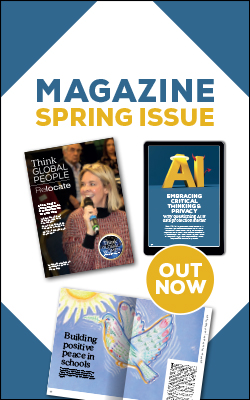Net migration figures – what isn’t being said
UK immigration is a hot-button political topic - as well as a critical issue for UK employers looking to fill key roles. Immigration lawyer Vanessa Ganguin analyses the data and concludes net migration has likely peaked at 606,000.

*Out now, the latest issue of Think Global People magazine*
Among the many utterances and reports on the UK’s latest immigration statistics, I have so far only seen immigration framed as a problem. And that is a major problem. When was the last time you saw immigration discussed in political circles as a solution to actual problems such as NHS waiting lists, inflation, having to retire later? Or just as a normal, age-old part of human lives? What’s more, when we discuss UK immigration figures, there’s some pretty important context that is all too often missed out: the topic is made to sound like some sort of great crisis rather than a customary part of our nation’s life. And this hysteria clouds all manner of discrimination against people because of where they’re born. Everybody seems to have a strong opinion about immigration figures right now, so please bear the following context in mind too.Related reading from Relocate Global
- UK expecting more visa curbs to cut migration
- Recruiters join calls for visa relaxation
- Immigration data shows UK net migration driven by 'real business need'
- Accelerating growth: are the brakes coming off global immigration policies?
Unusual circumstances made net migration spike last year
The immigration stats currently being used as a political football are for a post-pandemic period. They follow points during which global mobility almost ground to a halt.Students resumed in-person studies, so flooded back into education institutions. Companies bouncing back from the pandemic have had record skills shortages – many of which were filled by a spike (now going down again) in Skilled Worker visas – around a quarter of last year’s total. And these were dominated by the hiring of many much-needed healthcare workers addressing the unprecedented staffing crisis in the NHS and care sector. Though there are still over a million job vacancies nationwide, this week’s figures show net migration is no longer rising. Despite all the media hysteria, figures for the year ending December 2022 are down on the year ending October 2022. We should perhaps be more concerned that emigration has risen quite sharply and has been rising faster than immigration – but who talks about that?People fled Ukraine and Hong Kong
There is a war going on in Ukraine. Since the schemes for refugees from the Russian invasion of Ukraine were launched in early 2022, 174,200 have arrived in the UK; a further 25,700 extending their stays here. The year before, in response to crackdowns in Hong Kong, the UK Government launched its British Nationals Overseas (BNO) scheme, with 105,200 people arriving in the UK by December 2022 and 24,293 applying for the visa from within the UK. These are both unique schemes to offer safe, official routes to mass movements of people seeking sanctuary in the UK. Such large movements are unlikely to be repeated and at the same time, they are both responses that Britain can be proud of. Would anyone rather we hadn’t offered these humanitarian schemes?Migration was at record levels last year, but the latest ONS figures of 606,000 net migration show it has likely peaked, and with fewer students catching up on in-person studies and Ukraine and Hong Kong resettlement schemes appearing to have peaked, it is likely to settle again.There are no functioning safe routes for asylum – a tiny fraction of migration numbers
While we can be proud of the schemes set up for those fleeing war in Ukraine and persecution in Hong Kong, there are no safe routes functioning this well for refugees from any other part of the world. And that includes Afghanistan, where many who helped the British presence are still in hiding nearly two years after the evacuation, finding it very difficult to come to the UK safely. So please show charity and respect to those whose only way to seek sanctuary in the UK is by risking their lives in a dinghy across the Channel. Home Office stats on those claiming asylum after arriving in small boats find that most are genuine refugees. The 45,755 people detected arriving by small boats in 2022 are a tiny fraction of total UK immigration. And an even tinier fraction of all those seeking sanctuary in Europe. With over 100 million people displaced worldwide, the UK offered protection to just 23,841 people (including dependents) in 2022. If asylum numbers seem large, it is because a record backlog of people applying to be recognised as refugees has been allowed to build up through Home Office processing almost grounding to a halt.Net migration includes students – who generally leave again
The ONS this week explained that the post-pandemic spike in student visas has been followed by a record number of international students leaving the UK after their studies. While a record 361,000 arrived on study-related visas (including 85,000 dependants), students as a share of net migration fell as large numbers graduated and returned home.Unlike some other countries, the UK has chosen to count students in net migration figures. Records thus far have always shown that the vast majority of students leave again once their studies have finished, having helped to fund our higher education system which is the envy of the world. Just last week, a report by Universities UK International and the Higher Education Policy Institute estimated that international students boosted the British economy by an estimated £42 billion in the year 2021-2022.Student migration numbers jump about from year to year. Arguably, if students didn’t count towards net migration – only the small minority who decide to stay and switch to another visa – it would be far more useful, especially as the government may have different objectives, such as increasing international student numbers and decreasing net migration.The government’s plans (endorsed by Labour) to force postgraduate students to leave family at home will not only persuade many of the brightest and best talent in the world to contribute to other hubs of excellence around the world, but also discriminate against female talent.Targets to reduce net migration never work (unless you have a pandemic)
Ever since David Cameron was rash enough to set a target amount for net migration, it’s never been met apart from – and not long after Boris Johnson gave up on such targets – during the one-off global pandemic when net migration dropped 88 per cent (unsurprisingly bouncing right back).Stop saying it’s a choice between hiring from abroad and training up locals
The Prime Minister, the Chancellor of the Exchequer and both their opposition counterparts have all recently framed the debate on UK skills shortages as one of whether companies hire from abroad or invest in training the local workforce.Yet this week the CIPD – the HR industry’s professional body – surveyed members and published interesting findings that show this is a false dichotomy. Their survey found that employers that have sponsored migrant workers since 2021 were also more likely than other employers to have invested in upskilling British workers and hiring apprentices.It just isn’t true that immigration is taking opportunities away from resident workers.The post-Brexit workplace landscape is actually one where some employers that have the resources to invest in sponsoring foreign talent and invest in training, while less well-resourced organisations are struggling to do either.The British public appreciates immigration
Politicians seem increasingly out of step with what polling tells us about the British public. According to polling tracking British opinions since 2015 by Ipsos and British Future, support for reducing immigration is at its lowest, with more people happy with current levels or more. Research by The Policy Unit at King’s College London found attitudes to immigration in the UK are among the most positive in the world, with Brits topping a list of countries in increasingly appreciating the benefits immigration brings. And a YouGov poll asking “should Britain allow people fleeing persecution or war in other countries to come and live in Britain?” consistently finds the large majority of Brits would rather offer the current amount or more people sanctuary, with only nine per cent thinking none at all should be offered asylum.Still demonising immigration is a dangerous game to play. Monitoring from HOPE not hate revealed last weekend that far-right activity online spikes around key government announcements on immigration and related media coverage. HOPE not hate’s Stoking The Flames report highlights the worrying impacts of hostile language and policy in feeding the far-right extremists the organisation monitors and warns “politicians and the media need to take real responsibility and drop their line of inflammatory language that incubates the far right.”Lastly, please consider immigrants
As an immigration solicitor, I’m sure all my clients in the city of London and across the nations of the UK, as well as the many British firms employing them, would all appreciate a less hostile, more appreciative tone when discussing net migration. Immigrants aren’t statistics. They are people, like you and me.Please remember you may well one day be an immigrant yourself (yes, ending freedom of movement has made that harder, but you never know) so please talk about immigration in the same way that you would like politicians to talk about you, wherever you might move to.Come to the Innovation Festival for Global Working to explore the impact of global mobility on business and growth and share your views on 8 June.
Subscribe to Relocate Extra, our monthly newsletter, to get all the latest international assignments and global mobility news.Relocate’s new Global Mobility Toolkit provides free information, practical advice and support for HR, global mobility managers and global teams operating overseas.
©2025 Re:locate magazine, published by Profile Locations, Spray Hill, Hastings Road, Lamberhurst, Kent TN3 8JB. All rights reserved. This publication (or any part thereof) may not be reproduced in any form without the prior written permission of Profile Locations. Profile Locations accepts no liability for the accuracy of the contents or any opinions expressed herein.


































